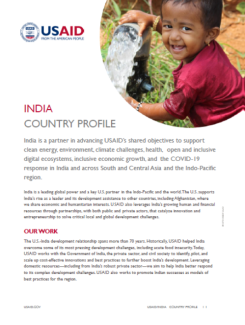India is a partner in advancing USAID’s shared objectives to support clean energy, environment, climate challenges, health, open and inclusive digital ecosystems, inclusive economic growth, and the COVID-19 response in India and across South and Central Asia and the Indo-Pacific region.
India is a leading global power and a key U.S. partner in the Indo-Pacific and the world. The U.S. supports India’s rise as a leader and its development assistance to other countries, including Afghanistan, where we share economic and humanitarian interests. USAID also leverages India’s growing human and financial resources through partnerships, with both public and private actors, that catalyze innovation and entrepreneurship to solve critical local and global development challenges.
OUR WORK
The U.S.-India development relationship spans more than 70 years. Historically, USAID helped India overcome some of its most pressing development challenges, including acute food insecurity. Today, USAID works with the Government of India, the private sector, and civil society to identify, pilot, and scale up cost-effective innovations and best practices to further boost India’s development. Leveraging domestic resources—including from India’s robust private sector—we aim to help India better respond to its complex development challenges. USAID also works to promote Indian successes as models of best practices for the region.
HEALTH
India has the second-highest cases of global COVID-19 infections. USAID support has helped India strengthen health system resilience, readiness, response capacity, address stigma, and mobilize innovative financing mechanisms for emergency preparedness and response to the pandemic. USAID also helped India to address bottlenecks at different stages of the supply chain for HIV, TB, contraceptive, and other critical healthcare drugs and equipment, which are vital both for India and the world given that India’s pharmaceutical industry supplies 80 percent of the world’s medicines.
High rates of child and maternal death, widespread malnutrition, and persistently high TB and HIV rates threaten the lives and productivity of India’s expanding population. Exacerbating India’s health challenges, access to clean water and functioning toilets escapes about 40 percent of the population—making India home to the world’s highest number of diarrhea-related deaths in children under 5. USAID leverages Indian resources to strengthen the reach, affordability and quality of health care services. Also, with USAID support, since 2014, India has declared more than 4,000 cities open defecation-free, reducing the potential for health hazards.
ENERGY AND ENVIRONMENT
India is the third largest emitter of greenhouse gas (GHG) in the world. India is also home to nine of the world’s ten most polluted cities, with 1.7 million deaths, 18 percent of total deaths in the country, attributable to air pollution in 2019. India is a priority country for the U.S. climate diplomacy and a longstanding strategic partner on clean energy research, development, and deployment, and management of targeted forest landscapes and forested watersheds. USAID, in partnership with the Government of India, and the U.S. and Indian private sector, focuses on assisting India and other South Asian Countries to transition to a “high-performing, low-emission, energy secure” economy. Between 2015 and 2018, USAID’s partnership helped improve access to modern, clean energy for more than 5 million people across India, reducing the amount of toxins in the air.
PROMOTING REGIONAL STABILITY
India plays a critical role in promoting regional and global stability. Increased trade, cross-border connectivity and India’s foreign assistance are helping to stabilize and spur economic growth in the region. USAID works together with India’s Development Partnership Administration on joint projects in the Indo-Pacific to provide capacity-building in third countries.

